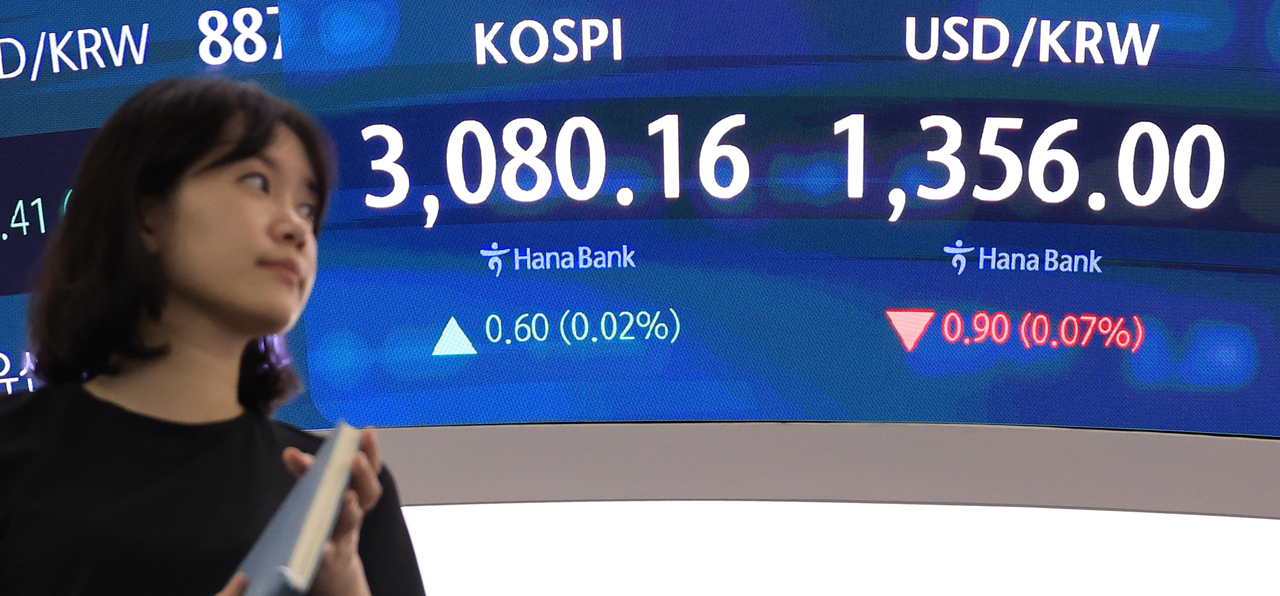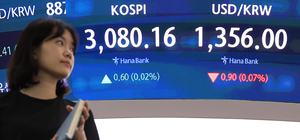Postelection rally drives 27% surge, but analysts warn of overheating risks
 An electronic board at Hana Bank’s dealing room in central Seoul shows the Kospi at 3,080.16 and the Korean won trading at 1,356 won per dollar on Friday morning. (Yonhap)
An electronic board at Hana Bank’s dealing room in central Seoul shows the Kospi at 3,080.16 and the Korean won trading at 1,356 won per dollar on Friday morning. (Yonhap) South Korea’s benchmark Kospi surged 27 percent in the first half of 2025, its strongest performance in over two decades, as investor optimism swelled under the new administration. But with valuations stretched, analysts warn the rally may be overheating the market, raising the risk of a correction.
The index jumped from 2,399.49 at the end of last year to 3,055.94 on Friday, according to Korea Exchange data. The gain is more than five times the 5.4 percent rise seen in the same period last year and marks the steepest first-half increase since 1999, when the Kospi soared 57 percent amid the dot-com boom.
Other historic first-half rallies were recorded in the 1980s, when Korea enjoyed broad-based growth amid a weak dollar, low interest rates and falling oil prices. The Kospi climbed 51 percent in the first half of 1987, 49 percent in 1986 and 41 percent and 34 percent in each of 1981 and 1988.
More recently, the main board rose 23.6 percent in the first half of 2009, as markets rebounded from the global financial crisis.
With Monday as the last trading day left in the first half, the Kospi is on track to notch its biggest first-half gain in 26 years, provided it does not fall by more than 2.95 percent. A sharper drop would still likely leave the index with its strongest start to a year since 2009.
Much of the surge came in the past month, with the Kospi jumping 13.2 percent in June alone.
The rally has been driven by the resolution of political uncertainty and expectations of market-friendly policies under President Lee Jae Myung, who has pledged to lift the Kospi to 5,000 points through measures aimed at revitalizing capital markets and boosting corporate competitiveness.
Still, signs of overheating are mounting.
As of Thursday, 10 stocks had been designated as an “investment risk” — the highest warning level under the Korea Exchange’s market monitoring system — up from six in the same period last year. “Investment alert” designations rose 55 percent to 175, while “investment caution” flags climbed 27 percent to 1,176 over the same period.
The trend intensified in June, with 30 stocks labeled “short-term overheated” as of Thursday — nearly triple March’s tally of 11, and significantly above the 22 and 17 recorded in April and May, respectively.
Experts also warned that external risks could weigh on market sentiment. Washington granted a three-month reprieve until July 9 on “reciprocal tariffs” targeting South Korean imports, aiming to reach a bilateral deal on revised trade terms.
“With the Kospi nearing an all-time high, upcoming noise from tariffs and political events could increase pressure for profit-taking,” said Lee Kyoung-min, an analyst at Daishin Securities.
“The Kospi is in overbought territory, and the 90-day grace period for reciprocal tariffs is coming to an end,” said Lee Eun-taek, an equity strategist at KB Securities. “Tariff threats are highly likely to resurface, and while such risks are nothing new, the market is unlikely to remain unaffected — especially amid growing concerns over an economic slowdown.”
After crossing 3,000 points for the first time in nearly 3 1/2 years on June 20, the Kospi quickly climbed past 3,100 the following session, approaching levels last seen in September 2021 and nearing its all-time high of 3,305 set in July 2021.
Even so, many analysts expect the Kospi to continue climbing toward year-end, viewing any pullback as a buying opportunity, depending on earnings momentum.
“For policy-driven sectors such as nuclear power, software, and finance, it’s wiser to wait for a pullback rather than chase the rally, while undervalued sectors — such as semiconductors, automobiles and retail — may present opportunities as capital rotation continues across industries,” said Daishin’s Lee Kyoung-min.
Shinhan Securities strategist Noh Dong-kil, who forecasts the Kospi could reach as high as 3,400 points by year-end on a valuation rerating, emphasized the growing importance of earnings.
“After the liquidity rally, earnings will become the key variable,” Noh said. “There’s a risk that third-quarter results may fall short of expectations due to weakening external demand. Only structurally growing stocks with low sensitivity to the economic cycle will be able to break through.”
jwc@heraldcorp.com
